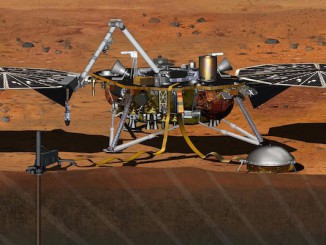
Amateur astronomers around the globe have a ringside seat as Comet 2013 A1 (Siding Spring) hurtles through space at over 160,000 kilometres an hour (100,000 miles an hour) en route to an incredibly close encounter with the planet Mars on Sunday, 19 October. The comet, estimated to have a nucleus 700 metres in size, will bypass the red planet by only 140,000 kilometres at 1830 UT.
Mars has been fading in brightness and shrinking in apparent diameter for months but it still shines as bright (magnitude +0.87) as the red star Aldebaran in Taurus and is readily visible to the unaided eye low in the south-south-west evening sky among the stars of Ophiuchus. Comet 2013 A1 (Siding Spring) had been on course to be as bright as mag. +8 but recently it has taken a bit of a plunge in its apparent brightness; the comet is on its first visit to the inner Solar System from the Oort cloud and in common with such objects its behaviour is notoriously difficult to predict. Current estimates place it around magnitude +10 with a 1.5-2 arcminute coma.
Tricky from the UK
The sky is pretty dark from London around 7pm, an hour after local sunset, with Mars and the comet just a couple of arcminutes apart, easily within a high power telescopic field but only about nine degrees above the horizon. This will be a very tricky observation to make but if you have access to an unobstructed horizon centre Mars in your eyepiece and try to see the comet.
Better in the USA
Conditions are more favourable across the United States with Mars and the comet higher in the sky the further south you are located. Closest approach occurs in daylight but by 7.30pm EDT the sky is relatively dark in New York (about an hour and 20 minutes after sunset) and the pair are still only separated by just over 10 arcminutes and just short of 15 degrees about the horizon. In Miami it gets dark around 8pm (an hour and 10 minutes after sunset) and the pair are a much more favourable 25 degrees up. Astrophotographers with moderate to large telescopes might be able to secure some decent frames of this historic encounter.
Best in Australia and New Zealand
Observers can see comet Siding Spring about half a degree from Mars on the evenings of 19 and 20 October with the pair about 40 degrees above the western horizon at 8.30pm local Sydney daylights saving time (80 minutes after sunset). The sky is almost astronomically dark at this time and coupled with the much more favourable altitude, visual and digital observers have a much better chance of seeing and imaging the comet which is only four to five Mars diameters away.

Astronomy Now would be delighted to receive your images and sketches of the comet’s encounter with Mars; please send them to gallery2014 @ astronomynow.com



